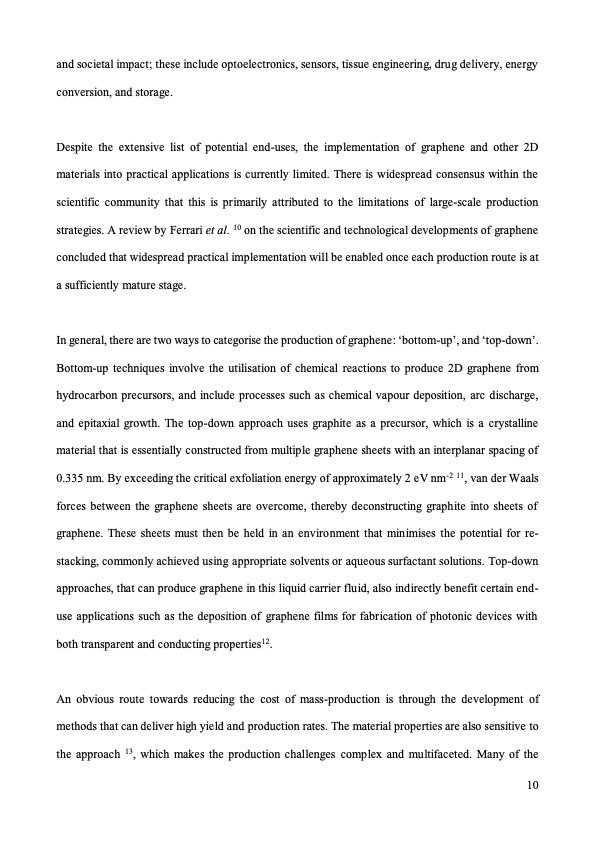PDF Publication Title:
Text from PDF Page: 010
and societal impact; these include optoelectronics, sensors, tissue engineering, drug delivery, energy conversion, and storage. Despite the extensive list of potential end-uses, the implementation of graphene and other 2D materials into practical applications is currently limited. There is widespread consensus within the scientific community that this is primarily attributed to the limitations of large-scale production strategies. A review by Ferrari et al. 10 on the scientific and technological developments of graphene concluded that widespread practical implementation will be enabled once each production route is at a sufficiently mature stage. In general, there are two ways to categorise the production of graphene: ‘bottom-up’, and ‘top-down’. Bottom-up techniques involve the utilisation of chemical reactions to produce 2D graphene from hydrocarbon precursors, and include processes such as chemical vapour deposition, arc discharge, and epitaxial growth. The top-down approach uses graphite as a precursor, which is a crystalline material that is essentially constructed from multiple graphene sheets with an interplanar spacing of 0.335 nm. By exceeding the critical exfoliation energy of approximately 2 eV nm-2 11, van der Waals forces between the graphene sheets are overcome, thereby deconstructing graphite into sheets of graphene. These sheets must then be held in an environment that minimises the potential for re- stacking, commonly achieved using appropriate solvents or aqueous surfactant solutions. Top-down approaches, that can produce graphene in this liquid carrier fluid, also indirectly benefit certain end- use applications such as the deposition of graphene films for fabrication of photonic devices with both transparent and conducting properties12. An obvious route towards reducing the cost of mass-production is through the development of methods that can deliver high yield and production rates. The material properties are also sensitive to the approach 13, which makes the production challenges complex and multifaceted. Many of the 10PDF Image | graphene production via nonoxidizing liquid exfoliation

PDF Search Title:
graphene production via nonoxidizing liquid exfoliationOriginal File Name Searched:
Graphene-R2-review.pdfDIY PDF Search: Google It | Yahoo | Bing
Salgenx Redox Flow Battery Technology: Power up your energy storage game with Salgenx Salt Water Battery. With its advanced technology, the flow battery provides reliable, scalable, and sustainable energy storage for utility-scale projects. Upgrade to a Salgenx flow battery today and take control of your energy future.
CONTACT TEL: 608-238-6001 Email: greg@infinityturbine.com (Standard Web Page)